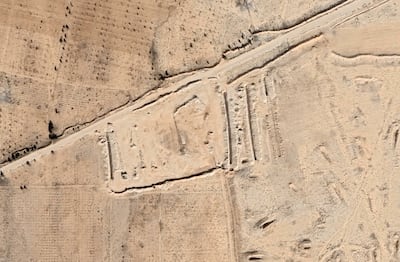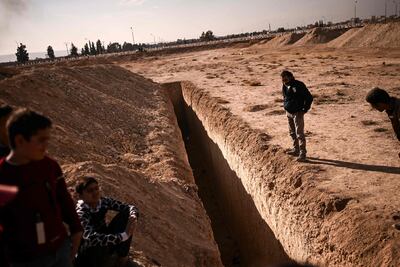Live updates: Follow the latest on Syria
Mass graves have begun to surface near Damascus following the fall of the Syrian regime, as field civil defence crews and NGOs initiate excavations in areas believed to hold the remains of hundreds of thousands of people.
On Tuesday, The National saw civil defence crews pull the remains of seven bodies from the ground of what was previously a secure zone in the town of Adra in the Damascus countryside. As with discoveries at other grave sites, the remains were found in canvas bags typically used to store dry goods like flour and lentils. Six of the seven sets of remains found were identified with names and corresponding numbers.
Hours before that, Mouaz Moustafa, who leads the Washington-based Syrian Emergency Task Force, told Reuters that the site at Al Qutayfah, 40km north of the Syrian capital, was one of five mass graves that he had identified over the years. “One hundred thousand is the most conservative estimate” of the number of bodies buried at the site, said Mr Moustafa.
Hundreds of thousands of Syrians are estimated to have been killed since 2011, when forces loyal to the ousted dictator Bashar Al Assad turned protests against his rule into a full-scale civil war. About 150,000 people remain unaccounted for as a result of the civil war, according to the International Commission on Missing Persons (ICMP).
The mass search for missing people began after Mr Al Assad was removed from power more than a week ago. With a change of government under way, many Syrians are desperately trying to find out what happened to loved ones who were detained by Syrian security forces and held in the regime's notorious prisons.
But the logistical challenges are enormous. Only 100 out of 3,000 White Helmets Civil Defence crews are operating on the ground in Damascus, and only 10 of those can respond to reports of bodies in mass-grave sites for the time being. The remaining 90 crews are conducting emergency response. They are still finding bodies in prisons, security branches, and military hospitals.
"This is a very rapid response because we were based in northern Syria. But now we’ve [had to] restructure ourselves to respond in Aleppo, Hama, Homs, Damascus and other areas,” Abdelrahman Al Mawwas, the evidence collecting and archiving manager of the White Helmets, told The National in Adra.
“We’ve responded to 508 unidentified dead bodies,” found in the Syrian regime’s notorious detention centres and military hospitals," he added. In one of the most notorious prisons of the Assad regime, Sednaya prison, also known as “the human slaughterhouse”, about 4,300 prisoners were reportedly freed after rebel fighters took over the area, according to documentation from the Syrian Civil Defence.
Experts have warned of the need to protect evidence and preserve crime scenes, including mass graves, to ensure accountability and justice. On Monday, the UN Syria Commission of Inquiry urged Syria’s caretaker government to protect arrest and detention files where they were discovered, ensuring their preservation for future justice processes.
The area in Adra where the bodies were found on Tuesday used to be a military zone and civilians were not allowed to go there. A resident of the town, Khaled Saleh Al Hamad, said security forces would previously snipe at anyone who approached the security area.
The National found evidence of further bodies buried in the Adra site shortly after civil defence crews left, with a strong smell emanating from a grave covered by a square cement block. Mr Mawwas estimated that search crews were likely to be excavating mass graves and uncovering bodies for years to come, but that given their current capacity in the wake of the sudden overthrow of the Syrian regime, making significant progress will be a major challenge.
“It’s really difficult to move vehicles and personnel [from place to place], so we are trying to do our best,” he said. He called on international organisations to provide support as they begin the work of exhuming the mass graves.
“We didn't receive any offers of help [yet],” he added. “As you see it’s been over 10 days [since the fall of the Assad regime] and journalists like you can come and work here. I don't know what the international organisations are waiting for."
Our legal consultant
Name: Dr Hassan Mohsen Elhais
Position: legal consultant with Al Rowaad Advocates and Legal Consultants.
START-UPS%20IN%20BATCH%204%20OF%20SANABIL%20500'S%20ACCELERATOR%20PROGRAMME
%3Cp%3E%3Cstrong%3ESaudi%20Arabia%3C%2Fstrong%3E%3C%2Fp%3E%0A%3Cp%3E%3Cstrong%3EJoy%3A%3C%2Fstrong%3E%20Delivers%20car%20services%20with%20affordable%20prices%3C%2Fp%3E%0A%3Cp%3E%3Cstrong%3EKaraz%3A%3C%2Fstrong%3E%20Helps%20diabetics%20with%20gamification%2C%20IoT%20and%20real-time%20data%3C%2Fp%3E%0A%3Cp%3E%3Cstrong%3EMedicarri%3A%3C%2Fstrong%3E%20Medical%20marketplace%20that%20connects%20clinics%20with%20suppliers%3C%2Fp%3E%0A%3Cp%3E%3Cstrong%3EMod5r%3C%2Fstrong%3E%3A%20Makes%20automated%20and%20recurring%20investments%20to%20grow%20wealth%3C%2Fp%3E%0A%3Cp%3E%3Cstrong%3EStuck%3A%3C%2Fstrong%3E%20Live%2C%20on-demand%20language%20support%20to%20boost%20writing%3C%2Fp%3E%0A%3Cp%3E%3Cstrong%3EWalzay%3A%3C%2Fstrong%3E%20Helps%20in%20recruitment%20while%20reducing%20hiring%20time%3C%2Fp%3E%0A%3Cp%3E%3Cstrong%3EUAE%3C%2Fstrong%3E%3C%2Fp%3E%0A%3Cp%3E%3Cstrong%3EEighty6%3A%20%3C%2Fstrong%3EMarketplace%20for%20restaurant%20and%20supplier%20procurements%3C%2Fp%3E%0A%3Cp%3E%3Cstrong%3EFarmUnboxed%3A%20%3C%2Fstrong%3EHelps%20digitise%20international%20food%20supply%20chain%3C%2Fp%3E%0A%3Cp%3E%3Cstrong%3ENutriCal%3A%3C%2Fstrong%3E%20Helps%20F%26amp%3BB%20businesses%20and%20governments%20with%20nutritional%20analysis%3C%2Fp%3E%0A%3Cp%3E%3Cstrong%3EWellxai%3A%3C%2Fstrong%3E%20Provides%20insurance%20that%20enables%20and%20rewards%20user%20habits%3C%2Fp%3E%0A%3Cp%3E%3Cstrong%3EEgypt%3C%2Fstrong%3E%3C%2Fp%3E%0A%3Cp%3E%3Cstrong%3EAmwal%3A%3C%2Fstrong%3E%20A%20Shariah-compliant%20crowd-lending%20platform%3C%2Fp%3E%0A%3Cp%3E%3Cstrong%3EDeben%3A%3C%2Fstrong%3E%20Helps%20CFOs%20manage%20cash%20efficiently%3C%2Fp%3E%0A%3Cp%3E%3Cstrong%3EEgab%3A%3C%2Fstrong%3E%20Connects%20media%20outlets%20to%20journalists%20in%20hard-to-reach%20areas%20for%20exclusives%3C%2Fp%3E%0A%3Cp%3E%3Cstrong%3ENeqabty%3A%3C%2Fstrong%3E%20Digitises%20financial%20and%20medical%20services%20of%20labour%20unions%3C%2Fp%3E%0A%3Cp%3E%3Cstrong%3EOman%3C%2Fstrong%3E%3C%2Fp%3E%0A%3Cp%3E%3Cstrong%3EMonak%3A%3C%2Fstrong%3E%20Provides%20financial%20inclusion%20and%20life%20services%20to%20migrants%3C%2Fp%3E%0A
MATCH INFO
Fixture: Ukraine v Portugal, Monday, 10.45pm (UAE)
TV: BeIN Sports
Roll%20of%20Honour%2C%20men%E2%80%99s%20domestic%20rugby%20season
%3Cp%3E%3Cstrong%3EWest%20Asia%20Premiership%3C%2Fstrong%3E%0D%3Cbr%3EChampions%3A%20Dubai%20Tigers%0D%3Cbr%3ERunners%20up%3A%20Bahrain%0D%3C%2Fp%3E%0A%3Cp%3E%3Cstrong%3EUAE%20Premiership%3C%2Fstrong%3E%0D%3Cbr%3EChampions%3A%20Jebel%20Ali%20Dragons%0D%3Cbr%3ERunners%20up%3A%20Dubai%20Hurricanes%0D%3C%2Fp%3E%0A%3Cp%3E%3Cstrong%3EUAE%20Division%201%3C%2Fstrong%3E%0D%3Cbr%3EChampions%3A%20Dubai%20Sharks%0D%3Cbr%3ERunners%20up%3A%20Abu%20Dhabi%20Harlequins%20II%0D%3C%2Fp%3E%0A%3Cp%3E%3Cstrong%3EUAE%20Division%202%3C%2Fstrong%3E%0D%3Cbr%3EChampions%3A%20Dubai%20Tigers%20III%0D%3Cbr%3ERunners%20up%3A%20Dubai%20Sharks%20II%0D%3C%2Fp%3E%0A%3Cp%3E%3Cstrong%3EDubai%20Sevens%3C%2Fstrong%3E%0D%3Cbr%3EChampions%3A%20Dubai%20Tigers%0D%3Cbr%3ERunners%20up%3A%20Dubai%20Hurricanes%3C%2Fp%3E%0A
Name: Peter Dicce
Title: Assistant dean of students and director of athletics
Favourite sport: soccer
Favourite team: Bayern Munich
Favourite player: Franz Beckenbauer
Favourite activity in Abu Dhabi: scuba diving in the Northern Emirates
NEW%20PRICING%20SCHEME%20FOR%20APPLE%20MUSIC%2C%20TV%2B%20AND%20ONE
%3Cp%3E%3Cstrong%3EApple%20Music%3Cbr%3EMonthly%20individual%3A%20%3C%2Fstrong%3E%2410.99%20(from%20%249.99)%3Cstrong%3E%3Cbr%3EMonthly%20family%3A%20%3C%2Fstrong%3E%2416.99%20(from%20%2414.99)%3Cstrong%3E%3Cbr%3EIndividual%20annual%3A%20%3C%2Fstrong%3E%24109%20(from%20%2499)%3C%2Fp%3E%0A%3Cp%3E%3Cstrong%3EApple%20TV%2B%3Cbr%3EMonthly%3A%20%3C%2Fstrong%3E%246.99%20(from%20%244.99)%3Cstrong%3E%3Cbr%3EAnnual%3A%20%3C%2Fstrong%3E%2469%20(from%20%2449.99)%3C%2Fp%3E%0A%3Cp%3E%3Cstrong%3EApple%20One%3Cbr%3EMonthly%20individual%3A%20%3C%2Fstrong%3E%2416.95%20(from%20%2414.95)%3Cstrong%3E%3Cbr%3EMonthly%20family%3A%20%3C%2Fstrong%3E%2422.95%20(from%20%2419.95)%3Cstrong%3E%3Cbr%3EMonthly%20premier%3A%20%3C%2Fstrong%3E%2432.95%20(from%20%2429.95)%3C%2Fp%3E%0A
Other workplace saving schemes
- The UAE government announced a retirement savings plan for private and free zone sector employees in 2023.
- Dubai’s savings retirement scheme for foreign employees working in the emirate’s government and public sector came into effect in 2022.
- National Bonds unveiled a Golden Pension Scheme in 2022 to help private-sector foreign employees with their financial planning.
- In April 2021, Hayah Insurance unveiled a workplace savings plan to help UAE employees save for their retirement.
- Lunate, an Abu Dhabi-based investment manager, has launched a fund that will allow UAE private companies to offer employees investment returns on end-of-service benefits.
Dubai Bling season three
Cast: Loujain Adada, Zeina Khoury, Farhana Bodi, Ebraheem Al Samadi, Mona Kattan, and couples Safa & Fahad Siddiqui and DJ Bliss & Danya Mohammed
Rating: 1/5
'Unrivaled: Why America Will Remain the World’s Sole Superpower'
Michael Beckley, Cornell Press
Indoor Cricket World Cup
Venue Insportz, Dubai, September 16-23
UAE squad Saqib Nazir (captain), Aaqib Malik, Fahad Al Hashmi, Isuru Umesh, Nadir Hussain, Sachin Talwar, Nashwan Nasir, Prashath Kumara, Ramveer Rai, Sameer Nayyak, Umar Shah, Vikrant Shetty
LA LIGA FIXTURES
Friday Valladolid v Osasuna (Kick-off midnight UAE)
Saturday Valencia v Athletic Bilbao (5pm), Getafe v Sevilla (7.15pm), Huesca v Alaves (9.30pm), Real Madrid v Atletico Madrid (midnight)
Sunday Real Sociedad v Eibar (5pm), Real Betis v Villarreal (7.15pm), Elche v Granada (9.30pm), Barcelona v Levante (midnight)
Monday Celta Vigo v Cadiz (midnight)
Wicked: For Good
Director: Jon M Chu
Starring: Ariana Grande, Cynthia Erivo, Jonathan Bailey, Jeff Goldblum, Michelle Yeoh, Ethan Slater
Rating: 4/5
AUSTRALIA SQUAD v SOUTH AFRICA
Aaron Finch (capt), Shaun Marsh, Travis Head, Chris Lynn, Glenn Maxwell, D'Arcy Short, Marcus Stoinis, Alex Carey, Ashton Agar, Mitchell Starc, Josh Hazlewood, Pat Cummins, Nathan Coulter-Nile, Adam Zampa
'Operation Mincemeat'
Director: John Madden
Cast: Colin Firth, Matthew Macfayden, Kelly Macdonald and Penelope Wilton
Rating: 4/5
COMPANY PROFILE
Name: Rain Management
Year started: 2017
Based: Bahrain
Employees: 100-120
Amount raised: $2.5m from BitMex Ventures and Blockwater. Another $6m raised from MEVP, Coinbase, Vision Ventures, CMT, Jimco and DIFC Fintech Fund
THE BIO
Ambition: To create awareness among young about people with disabilities and make the world a more inclusive place
Job Title: Human resources administrator, Expo 2020 Dubai
First jobs: Co-ordinator with Magrudy Enterprises; HR coordinator at Jumeirah Group
Entrepreneur: Started his own graphic design business
Favourite singer: Avril Lavigne
Favourite travel destination: Germany and Saudi Arabia
Family: Six sisters
The specs
Engine: 2.2-litre, turbodiesel
Transmission: 6-speed auto
Power: 160hp
Torque: 385Nm
Price: Dh116,900
On sale: now
UAE currency: the story behind the money in your pockets
Test
Director: S Sashikanth
Cast: Nayanthara, Siddharth, Meera Jasmine, R Madhavan
Star rating: 2/5
The bio
Date of Birth: April 25, 1993
Place of Birth: Dubai, UAE
Marital Status: Single
School: Al Sufouh in Jumeirah, Dubai
University: Emirates Airline National Cadet Programme and Hamdan University
Job Title: Pilot, First Officer
Number of hours flying in a Boeing 777: 1,200
Number of flights: Approximately 300
Hobbies: Exercising
Nicest destination: Milan, New Zealand, Seattle for shopping
Least nice destination: Kabul, but someone has to do it. It’s not scary but at least you can tick the box that you’ve been
Favourite place to visit: Dubai, there’s no place like home
'Doctor Strange in the Multiverse Of Madness'
Director: Sam Raimi
Cast: Benedict Cumberbatch, Elizabeth Olsen, Chiwetel Ejiofor, Benedict Wong, Xochitl Gomez, Michael Stuhlbarg and Rachel McAdams
Rating: 3/5
Polarised public
31% in UK say BBC is biased to left-wing views
19% in UK say BBC is biased to right-wing views
19% in UK say BBC is not biased at all
Source: YouGov





